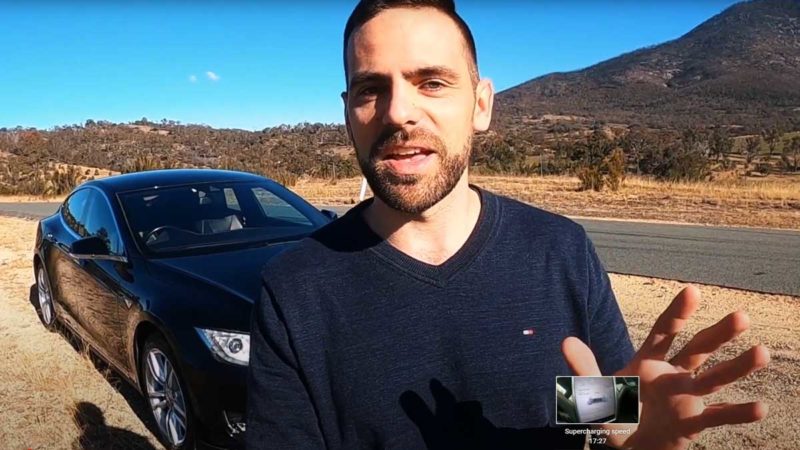Tesla hire car company owner Slava Kozlovskii has shared his experience of owning a Tesla Model S for four years and how it has performed after driving 160,000km as a rental vehicle.
Kozlovskii started the electric car hire business Evee in 2019 and it now has vehicles for hire in Sydney, Melbourne, Brisbane, Adelaide, Perth, Tasmania, Canberra, the Gold Coast, Byron Bay and even in Alice Springs.
He says he made the video for the vehicle, which he is soon putting up for sale, to help “change more minds and bust more myths about EV reliability.”
“I discuss battery capacity loss, supercharging speed, purchase and sale prices, cost of service also that renting it out has proven to be a good idea,” Kozlovskii told The Driven in a note by email.
“I did my best to remain unbiased and highlight the good things as well as the bad ones.”
It’s a very informative review. From purchase and sale price, it goes into how renting it out has filled that financial gap, what costs were involved, as well as how the vehicle has held up to the demands of being a rental vehicle including battery capacity and supercharging.
The vehicle in question is a rear-wheel drive Model S with 70 kWh battery – the base variant when it was bought for $140,000 in 2016 – and which came with Enhanced Autopilot and hardware version 1.0.
“I think it’s held up its value pretty well comparing to any other petrol car now today,” says Kozlovskii in the review video which you can view below, adding he is now selling it for $66,000.
“We’ve done an average of about 40,000 km a year or so, that was on highways and travelling from Sydney and Canberra and whenever it was rented …. road trips to regional Australia as well.”
He says that in all that time, the battery capacity has only dropped 9 per cent.
“When we were originally charging it to 100% it would show about 365km on full charge and now it shows 332km when it’s warmer outside – it actually goes a bit higher [in cooler weather] to 336km, so it’s about 8-9% battery capacity loss in this time,” he says, adding that the most interesting thing was most of this was lost in the first 80,000 km.
In that time, “The performance and handling of this car has literally not changed whatsoever,” he says.
“There is nothing that happens to the electric motors and it accelerates and forms and corners and handles as well as it did on day one which is which is incredible.
“It sticks to the road corners as well the battery sits low in the middle of the car, with 50/50 distribution and it’s just a pleasure to drive.”
In terms of servicing and maintenance, he says there have been mainly electronic issues to deal with since the 80,000km warranty ran out, at a cost of around $10,000.
“Wile the car was still under warranty [there were] a couple of things but it didn’t bother us as it was under warranty. But soon after we ran out of warranty …. we had to replace MCU (the main media control unit) which is the main screen,” he says. “That was probably close to $4,000 to replace.”
He adds that the main DC charger also failed, which put a $3,500 hole in the pocket.
“Little things started to pile up as well such as door handles not popping up, and you know it’s $200, $300 here in there so in the last 18 months I probably spent close to $10,000 on servicing.”
“So I certainly recommend looking at some extended warranty options …. just because all the electronics start to play up a little bit with age and I’m sure the new cars are a lot more solid in this sense,” says Kozlovskii.
Despite the high cost of maintenance after the warranty ran out, the fact that the vehicle was making money more than compensated for this.
“Because we’ve been Renting this car now … it’s actually paid for all it’s costs including depreciation, insurance, service, everything included over 4 years,” he says.
He describes the extra room in the vehicle thanks to the “frunk” (or should it be called front boot, or “froot”, in Australia?), which has enough room for a stroller without detracting from rear cargo space.
He also notes that rear wheel drive Teslas tend to wear down the inner tread of the back tyres quickly.
“The interesting thing about the rear wheel drive Model S [wears out the inner rear tread] because [when you] accelerate it actually sort of sits down and so the inner tread has more friction with the road,” he says.
“Another thing is regeneration happens only on the rear wheels – there’s nothing on the front wheels that’s actually stopping the car except the actual physical mechanical brakes.”
Although the 2016 Model S came only with a single forward camera (new ones have eight around the vehicle to give full surround vision), Kozlovskii says it still performs functions such as lane assist and change quite well, and that driving between Sydney and Canberra he would have it on about 98% of the time.
As for supercharging, he admits that the maximum charge rate isn’t quite what it used to be – but that you really only need to charge to full capacity for longer trips.
“You only need that [full] battery capacity to actually travel between long distances between superchargers who for travelling from Sydney to Melbourne, your drive is 170 km 200 km, [then you] stop for 30 minutes supercharging and keep going.”
He performs a supercharger test: with just 15km left in the battery, he achieves a top charge rate of 108kW.
“When new it was 114-115kw,” he says, adding that the top charge rate drops quickly soon after charging commences.
“This is one thing about Tesla, you know they they say charging speed of 1,000 kilometres an hour …. on the newer vehicles which is true, but it’s only true for the first 10-15 minutes of charging.
“The fact that you can charge 1000 kilometres an hour for the first 5 minutes doesn’t really affect the total charging time,” he says. To charge to full now takes him around 2.5 hours, although generally Tesla owners will set a top limit of 80-90% as the last 10-20% charging takes so long.
The verdict? After 160,000km driving in four years, the 2016 Tesla Model S has lost 35km, or 9% of its driving range, and if Kozlovskii gets his asking price of $66,000, it will have lost 53% in value.

Bridie Schmidt is associate editor for The Driven, sister site of Renew Economy. She has been writing about electric vehicles since 2018, and has a keen interest in the role that zero-emissions transport has to play in sustainability. She has participated in podcasts such as Download This Show with Marc Fennell and Shirtloads of Science with Karl Kruszelnicki and is co-organiser of the Northern Rivers Electric Vehicle Forum. Bridie also owns a Tesla Model Y and has it available for hire on evee.com.au.


